
Giunta Pisano (also named Giunta da Pisa or Giunta Capitini) was an Italian painter. He is the earliest Italian painter whose name is found inscribed on an extant work. He is best known for his crucifixes.

Giunta Pisano (also named Giunta da Pisa or Giunta Capitini) was an Italian painter. He is the earliest Italian painter whose name is found inscribed on an extant work. He is best known for his crucifixes.
He is said to have exercised his art from 1202 to 1236. He may perhaps have been born towards 1180 in Pisa, and died in or soon after 1250, but other accounts give 1202 as the date of his birth, and the more probable date of 1258 or thereabouts for his death. There is some ground for thinking that his family name was Capiteno or Capitino.
Giunta Pisano usually painted upon cloth stretched on wood and prepared with plaster.
The inscribed work, referred to above, is also one of his earliest. It is the Crocefisso di San Raniero, a crucifix, that hung for a long time in the kitchen of the convent of St Anne in Pisa. Other Pisan works of about the same date (as the one in National Museum of San Matteo, Pisa) are very barbarous, and, some of them may be also from the hand of Giunta Pisano before he had achieved his virtuosity (such as S. Benedetto Crucifixion).
A painting of a crucifixion (1236) for the High Altar of the upper church of Assisi no longer exists, [1] but there exists an 18th-century engraving based on a copy of this portrait [2] In the sacristy is a portrait of St Francis, also ascribed to Giunta; but it more probably belongs to the close of the 13th century.
His masterpiece is the imposing Crucifix (1250) in the left transept of Basilica of Saint Dominic in Bologna, with the writing in Latin "Cuius docta manus me pixit Junta Pisanus" (painted by the learned or skilled hand of Giunta Pisano). It is still much influenced by the Byzantine style and represents one of the best examples of 13th-century Italian painting.
These crucifixes show that he initiated a new way of representing Christ, eventually substituting once and for all the traditional Byzantine image of Jesus serene though crucified (Christus gloriosus) with a Christ dying in agony (Christus patiens). This representation of Christ, and especially the crucifix in Basilica of St Dominic in Bologna, has much influenced Cimabue, who would continue on this style and develop his own more emotional style (as seen in his Crucifix in Basilica di Santa Croce, Florence). Another thoroughly Giuntesque Crucifixion is the right wing of a diptych from the Veneto, found at the Chicago Art Institute. [3]
A number of unknown Italian artists have been identified as members of Giunta's circle; among them are the Master of the Blue Crucifixes, the Master of the Treasury, and Vicino da Pistoia. [4] He appears to have influenced Rainaldetto di Ranuccio of Spoleto. [5]
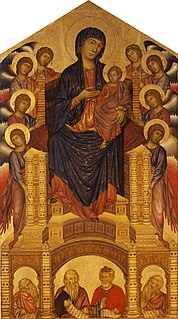
Cimabue, also known as Cenni di Pepo or Cenni di Pepi, was an Italian painter and designer of mosaics from Florence.

A crucifix is an image of Jesus on the cross, as distinct from a bare cross. The representation of Jesus himself on the cross is referred to in English as the corpus.

Duccio di Buoninsegna was an Italian painter active in Siena, Tuscany, in the late 13th and early 14th century. He was hired throughout his life to complete many important works in government and religious buildings around Italy. Duccio is considered one of the greatest Italian painters of the Middle Ages, and is credited with creating the painting styles of Trecento and the Sienese school. He also contributed significantly to the Sienese Gothic style.

Nicola Pisano was an Italian sculptor whose work is noted for its classical Roman sculptural style. Pisano is sometimes considered to be the founder of modern sculpture.
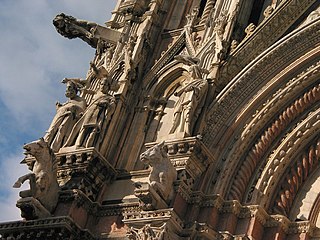
Giovanni Pisano was an Italian sculptor, painter and architect, who worked in the cities of Pisa, Siena and Pistoia. He is best known for his sculpture which shows the influence of both the French Gothic and the Ancient Roman art. Henry Moore, referring to his statues for the facade of Siena Cathedral, called him "the first modern sculptor".

Pietro Lorenzetti or Pietro Laurati was an Italian painter, active between c.1306 and 1345. Together with his younger brother Ambrogio, he introduced naturalism into Sienese art. In their artistry and experiments with three-dimensional and spatial arrangements, the brothers foreshadowed the art of the Renaissance.

The Basilica of Saint Mary of the Angels is a Papal minor basilica situated in the plain at the foot of the hill of Assisi, Italy, in the frazione of Santa Maria degli Angeli.

The Basilica of San Domenico is one of the major churches in Bologna, Italy. The remains of Saint Dominic, founder of the Order of Preachers (Dominicans), are buried inside the exquisite shrine Arca di San Domenico, made by Nicola Pisano and his workshop, Arnolfo di Cambio and with later additions by Niccolò dell'Arca and the young Michelangelo.
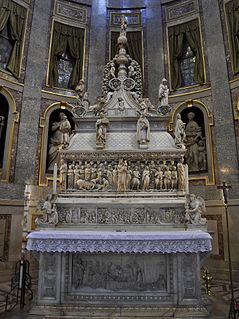
The Arca di San Domenico is a monument containing the remains of Saint Dominic. It is located in Dominic’s Chapel in the Basilica of San Domenico in Bologna, Italy.

The Master of Saint Francis was an anonymous Italian painter, perhaps of Pisan origin though probably trained in Umbria, working between 1250–1280. His work embodies an important aspect of the Italo-Byzantine style resulting from contact between Italian and Byzantine art of this period.

Pisa Cathedral is a medieval Roman Catholic cathedral dedicated to the Assumption of the Virgin Mary, in the Piazza dei Miracoli in Pisa, Italy, the oldest of the three structures in the plaza followed by the Pisa Baptistry and the Campanile known as the Leaning Tower of Pisa. The cathedral is a notable example of Romanesque architecture, in particular the style known as Pisan Romanesque. Consecrated in 1118, it is the seat of the Archbishop of Pisa. Construction began in 1063 and was completed in 1092. Additional enlargements and a new facade were built in the 12th century and the roof was replaced after damage from a fire in 1595.

The Crucifix of Pisa is a painting of the crucifixion painted on wood panel, dating to sometime around 1230 and currently in the Museo nazionale di San Matteo, Pisa, Italy. Its anonymous author is referred to as the Byzantine Master of the Crucifix of Pisa. He was an Italian painter active in Pisa in the first half of the thirteenth century. The painting is significant in the history of Italian painting for its iconography of the patient, suffering Christ on the cross; although then new, it quickly replaced the older style, depicting Christ triumphant and free from pain, with open eyes and a regal bearing free from sorrow.
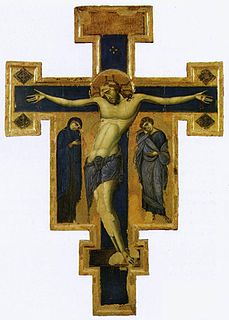
The Master of the Blue Crucifixes was an Italian artist active either in the region of Umbria or Emilia during the middle of the thirteenth century. He is associated with the Basilica of San Francesco d'Assisi, and may have been an assistant of Giunta Pisano, whose work his paintings resemble. A number of his works survive, mainly processional crucifixes, from which his name is derived.

Pistoia Cathedral, or Cathedral of Saint Zeno is the main religious building of Pistoia, Tuscany, central Italy, located in the Piazza del Duomo in the centre of the city. It is the seat of the Bishop of Pistoia and is dedicated to Saint Zeno of Verona.
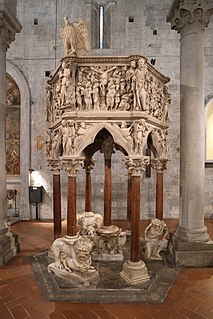
The pulpit in the pieve of Sant'Andrea, Pistoia, Italy is a masterpiece by the Italian sculptor Giovanni Pisano. The work is often compared to the pulpits sculpted by Giovanni's father Nicola Pisano in the Baptistery of Pisa and the Duomo of Siena, which Giovanni had assisted with. These very advanced works are often described in terms such as "proto-Renaissance", and draw on Ancient Roman sarcophagi and other influences to form a style that represents an early revival of classical sculpture, while also remaining Gothic, and drawing on sources such as French ivory carvings.

Berlinghiero also known as Berlinghiero Berlinghieri or Berlinghiero of Lucca, was an Italian painter in the Italo-Byzantine style of the early thirteenth century. He was the father of the painters Barone Berlinghieri, Bonaventura Berlinghieri, and Marco Berlinghieri.

The Crucifix by Cimabue at Santa Croce is a very large wooden crucifix, painted in distemper, attributed to the Florentine painter and mosaicist Cimabue, one of two large crucifixes attributed to him. The work was commissioned by the Franciscan friars of Santa Croce and is built from a complex arrangement of five main and eight ancillary timber boards. It is one of the first Italian artworks to break from the late medieval Byzantine style and is renowned for its technical innovations and humanistic iconography.

Igino Benvenuto Supino was an Italian painter, art critic, and historian.

The Crucifix by Cimabue at Arezzo is a large wooden crucifix painted in distemper, with gold leaf, by the Florentine painter and mosaicist Cimabue, dated to c. 1267–71. It is the earliest of two large crucifixes attributed to him. It shows a painted representation of the near dead body of Christ on the cross, with Mary, mother of Jesus and John the Evangelist at either end of the cross beams.
| Wikimedia Commons has media related to Giunta Pisano . |